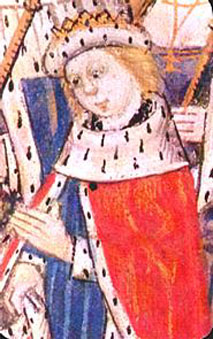Edward V of England
2008/9 Schools Wikipedia Selection. Related subjects: British History 1500 and before (including Roman Britain); Monarchs of Great Britain
|
||||||||||||||||||||||||||||||||||||||||
|
||||||||||||||||||||||||||||||||||||||||
Edward V ( 4 November 1470 – 1483?) was the King of England from 9 April 1483 until his deposition two months later. His reign was dominated by the influence of his uncle Richard, Duke of Gloucester, who succeeded him as Richard III. Along with his younger brother Richard of Shrewsbury, Edward was one of the Princes in the Tower, who were never seen alive after being sent (ostensibly for their own safety) to the Tower of London. Richard III has been widely blamed for their deaths, though it is not certain that he was responsible for them.
Along with Edward VIII and Lady Jane Grey, Edward V is one of only three post-1066 English monarchs never to have been crowned.
Early life
Edward was born in sanctuary within Westminster Abbey during a period when his mother, Elizabeth Woodville was taking refuge from Lancastrians who had temporarily removed King Edward IV of England from power in the War of the Roses. Edward V was created Prince of Wales in June, 1471, following his father's restoration to the throne, and appeared with his parents on State occasions.
King Edward IV concluded an alliance in 1480 with the Duke of Brittany, Francis II, and both decided to betroth their heirs, Edward (10 years old) and Anne (4 years old), to each other, promising to marry them at their majority. The devolution of Brittany would have been given to the second child to be born, the first becoming prince of Wales. Those plans disappeared together with Edward V.
Reign
Edward IV, having established a Council of Wales and the Marches, sent his son to Ludlow Castle to be its nominal president. It was at Ludlow that the prince was staying when news came of his father's sudden death. Edward inherited the throne on 9 April 1483, at the age of twelve, but it took until 11 April for news of his accession to be made public in London. His father's brother Richard, Duke of Gloucester, was entrusted with the role of Protector to his young nephews, Edward V and Richard, Duke of York. He intercepted Edward's entourage on its return journey from Wales and escorted the princes to London. Less than three months later, Richard took the throne himself. On 25 June Parliament declared his nephews illegitimate after clergyman Ralph Shaa presented evidence that Edward had contracted to marry Lady Eleanor Butler before he married Elizabeth Woodville; this would have made his marriage to Elizabeth invalid. Richard's other brothers, Edmund and George, Duke of Clarence, had both died before Edward, leaving Richard next in line for the throne.
Imprisonment
After the two boys went into the Tower of London, they were never seen in public again. What happened to them is one of the great mysteries of history, and many books have been written on the subject. It is generally believed that they were killed, and the three principal suspects are their uncle, King Richard; Henry Stafford, 2nd Duke of Buckingham; and Henry Tudor, who defeated Richard and took the throne as Henry VII.
Legacy
After the princes' disappearance, there was much uncertainty as to their fate. If they were killed, the secret was well kept; conversely, there was no evidence of their survival or of their having been shipped out of the country. When a pretender, Perkin Warbeck, turned up claiming to be Prince Richard, in 1495, William Stanley (younger brother of King Henry's stepfather, Thomas Stanley, 1st Earl of Derby), who, despite his Yorkist sympathies, had turned against Richard III at the Battle of Bosworth Field and helped King Henry VII win it, said that, if the young man was really the prince, he would not fight against him, thus demonstrating that some Yorkists had not given up hope of the princes' survival.
In 1674, some workmen remodelling the Tower of London dug up a box containing two small human skeletons. They threw them on a rubbish heap, but some days or weeks later someone decided they might be the bones of the two princes, so they gathered them up and put some of them in an urn that Charles II of England ordered interred in Westminster Abbey. In 1933 the bones were taken out and examined and then replaced in the urn in the vault under the Abbey. The experts who examined them could not agree on what age the children would have been when they died or even whether they were boys or girls. (One skeleton was larger than the other, and many of the bones were missing, including part of the smaller jawbone and all of the teeth from the larger one.)
Ancestors
| Edward V of England | Father: Edward IV of England |
Paternal Grandfather: Richard Plantagenet, 3rd Duke of York |
Paternal Great-grandfather: Richard of Conisburgh, 3rd Earl of Cambridge |
| Paternal Great-grandmother: Anne de Mortimer |
|||
| Paternal Grandmother: Cecily Neville |
Paternal Great-grandfather: Ralph de Neville, 1st Earl of Westmorland |
||
| Paternal Great-grandmother: Joan Beaufort, Countess of Westmorland |
|||
| Mother: Elizabeth Woodville |
Maternal Grandfather: Richard Woodville, 1st Earl Rivers |
Maternal Great-grandfather: Sir Richard Wydevill |
|
| Maternal Great-grandmother: Joan Bedlisgate |
|||
| Maternal Grandmother: Jacquetta of Luxembourg |
Maternal Great-grandfather: Pierre de Luxembourg, Comte de Saint Pol, Conversano et Brienne |
||
| Maternal Great-grandmother: Margaret de Baux |

